
Find the square root of the following decimal number
$\left( i \right)2.56$
$\left( ii \right)7.29$
$\left( iii \right)51.84$
$\left( iv \right)42.25$
$\left( v \right)31.36$
Answer
596.4k+ views
Hint: To find the square root of any number, we can use a long division method. This long division method can be also used to find the square root of a decimal number. Using this method, we can solve this question.
Complete step by step answer:
To solve this question, we can use a long division method which can be used to find the square root of any real number whether it is decimal or integer.
(i) 2.56
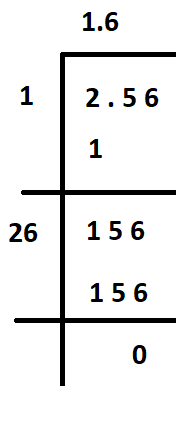
Hence, the square root of 2.56 is 1.6.
(ii) 7.29
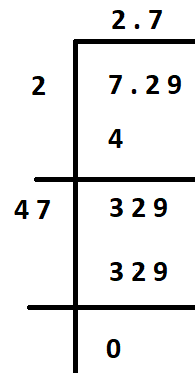
Hence, the square root of 7.29 is 2.7
(iii) 51.84
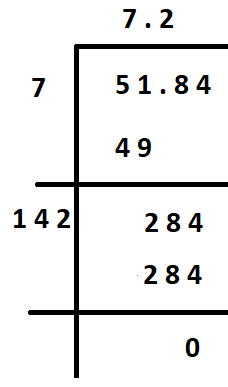
Hence, the square root of 51.84 is 7.2
(iv) 42.25
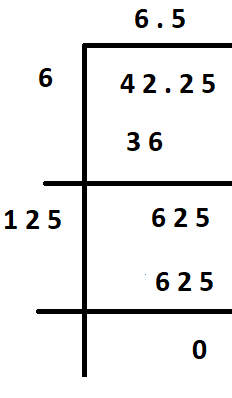
Hence, the square root of 42.25 is 6.5
(v) 31.36
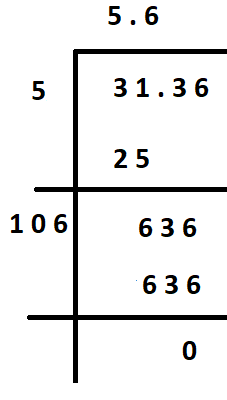
Hence, the square root of 31.36 is 5.6
Note: There is an alternate method using which, we can find the square root of a decimal number. In this method, we first convert a decimal number to the scientific form i.e. we write the decimal numbers in the form of power of 10. Now, we take the square root of this scientific form of number. We individually find the square root of the integer and the term ${{10}^{n}}$ where n is an integer. For example, if we have to find the square root of 2.56, we will first write it as $256\times {{10}^{-2}}$. Now, we will find the square root of this form which is equal to $\sqrt{256\times {{10}^{-2}}}$. This can be also written as $\sqrt{256}\times \sqrt{{{10}^{-2}}}$. We know that \[\sqrt{256}=16\] and \[\sqrt{{{10}^{-2}}}={{10}^{-1}}\]. Hence, we can write the square root of 2.56 as $16\times {{10}^{-1}}=1.6$.
Complete step by step answer:
To solve this question, we can use a long division method which can be used to find the square root of any real number whether it is decimal or integer.
(i) 2.56

Hence, the square root of 2.56 is 1.6.
(ii) 7.29

Hence, the square root of 7.29 is 2.7
(iii) 51.84

Hence, the square root of 51.84 is 7.2
(iv) 42.25

Hence, the square root of 42.25 is 6.5
(v) 31.36

Hence, the square root of 31.36 is 5.6
Note: There is an alternate method using which, we can find the square root of a decimal number. In this method, we first convert a decimal number to the scientific form i.e. we write the decimal numbers in the form of power of 10. Now, we take the square root of this scientific form of number. We individually find the square root of the integer and the term ${{10}^{n}}$ where n is an integer. For example, if we have to find the square root of 2.56, we will first write it as $256\times {{10}^{-2}}$. Now, we will find the square root of this form which is equal to $\sqrt{256\times {{10}^{-2}}}$. This can be also written as $\sqrt{256}\times \sqrt{{{10}^{-2}}}$. We know that \[\sqrt{256}=16\] and \[\sqrt{{{10}^{-2}}}={{10}^{-1}}\]. Hence, we can write the square root of 2.56 as $16\times {{10}^{-1}}=1.6$.
Recently Updated Pages
Master Class 8 Social Science: Engaging Questions & Answers for Success

Master Class 8 Maths: Engaging Questions & Answers for Success

Master Class 8 Science: Engaging Questions & Answers for Success

Class 8 Question and Answer - Your Ultimate Solutions Guide

Master Class 8 English: Engaging Questions & Answers for Success

Master Class 5 Maths: Engaging Questions & Answers for Success

Trending doubts
What is BLO What is the full form of BLO class 8 social science CBSE

Which one of the following groups comprises states class 8 social science CBSE

Citizens of India can vote at the age of A 18 years class 8 social science CBSE

Full form of STD, ISD and PCO

A couple went for a picnic They have 5 sons and each class 8 maths CBSE

Right to vote is a AFundamental Right BFundamental class 8 social science CBSE




